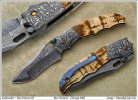- Joined
- Jan 9, 2011
- Messages
- 16,344
Lets talk folder making!
I am curious how everyone does the holes on their folders. What exact process do you use?
I just got a mill and am trying to dial in my process to get perfect holes... the right size and perfectly square.
I'll go first
- find starting point with a center finder
- start hole with a center drill
- drill undersized
- ream
Should I change from a collet to a chuck at any time? Use a chuck except on end mills?
Drill with end mills?
For counterbored holes (like a pivot) should I use a combined counterbore or smaler then larger end mill?
Do you stack the frame sides and drill both at once? Index?
Coolant? I'm using Titanium here...
Thanks in advance! I hope we have a fun discussion.
I am curious how everyone does the holes on their folders. What exact process do you use?
I just got a mill and am trying to dial in my process to get perfect holes... the right size and perfectly square.
I'll go first
- find starting point with a center finder
- start hole with a center drill
- drill undersized
- ream
Should I change from a collet to a chuck at any time? Use a chuck except on end mills?
Drill with end mills?
For counterbored holes (like a pivot) should I use a combined counterbore or smaler then larger end mill?
Do you stack the frame sides and drill both at once? Index?
Coolant? I'm using Titanium here...
Thanks in advance! I hope we have a fun discussion.


